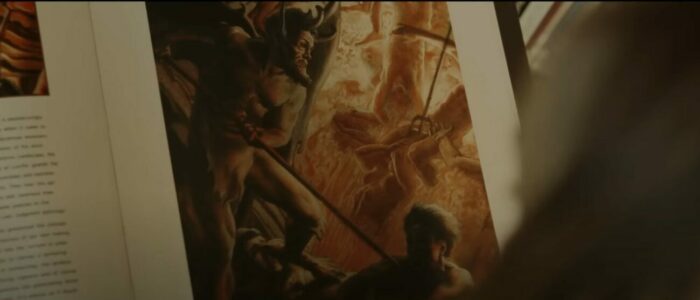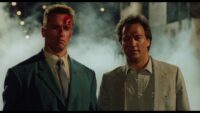Visual artist, film illustrator, and director Mauro Borrelli has worked on almost every major franchise in Hollywood (Pirates of the Caribbean, Star Wars, Marvel) and with some of the most famous filmmakers of all time. I recently sat down with Borrelli to discuss his newest picture, Mindcage, a psychological thriller starring Martin Lawrence, John Malkovich, and Melissa Roxburgh. We talked about his process for directing, how his background as an artist helped him, and how art inspired this newest film. I hope you enjoy this interview with Mindcage director Mauro Borrelli.
Film Synopsis: When a copycat murderer strikes, Detectives Jake Doyle and Mary Kelly seek help from an incarcerated serial killer called the Artist. As Mary delves deep into the Artist’s brilliant but twisted psyche, she and Jake get lured into a diabolical game of cat and mouse, racing against time to stay one step ahead of both criminals.
This interview has been edited for length and clarity; if you wish to listen to the full interview click the audio link below.
Byron Lafayette: Thanks so much for taking a few minutes to chat with me today about your new film. I think this is a very fascinating, topic that this film is tackling. What was the genesis of this project? How did it come together for you to work on it and all of that?
Mauro Borrelli: Well, the genesis is based on the desire of making something that combines my fine art background with, a commercial or more detective film. I like detective stories. So I said, well, I have to bring some fine art and some painting in there. So we start thinking about what are the elements that I like to talk about. I felt like fine art, supernatural, and detectives. You know, that’s how it started. We started having a talk about putting together a story. It went through many different layers and then we come out with this.
Byron Lafayette: You have a background as an illustrator and an artist. You’ve worked on some of the biggest movie franchises in the world. Being an artist having that sensibility, and directing this film where art is at the forefront, I wondered, did being an artist, yourself, influence how you directed this film?
Mauro Borrelli: Yeah, I think that influence comes from the method of approach. For example, when you do a classical academic painting. The first approach that you have is composition, and you have the sense of light and darkness, and you proceed in an academic way.
So my approach even in films is always based on art and my education in art. How I start with the sketch. For example, do you start with detail and then expand? Or you start with the sketch that gives the overall thing and then you go and refine it. I start with the sketch and then I refine it because that’s my education.
So on a film, I start to look at the scene as a generic thing, and then I start to move things inside and usually I use the same parameters as a composition. Because an actor’s performance also reflects composition. There is something in the timing that matches the composition.
That’s, usually my approach, I had experiences working with directors, where they come from pop culture, and, uh, and their choice are based. Whatever they learn from, maybe a magazine or whatever is hot, whatever is cool.
So they have a photographic memory of cool things and they put them together based on their choice made based on their pop culture or what they see that it was hot at the moment. But they don’t know why, I know more. Why? Because I’m based on the academic structure. So I know something works. It’s because you fit into the composition. It is all our composition is a goal composition. That’s my approach.
Byron Lafayette: Oh, that’s fascinating. One aspect of the film I did notice is that, with art itself, it’s to create, it’s to build up and the villain of the film, “The artist” is perverting art to tear down and destroy. So I was wondering if you could maybe elaborate on that a little bit as an artist yourself.
Mauro Borrelli: I thought it was interesting that, even though a crazy serial killer may have his own motivation, he tried to justify his action. This doesn’t mean I justify it, but I want to know why he does it. And I thought that his desire for learning how to paint when he was a kid was aiming to duplicate religious painting. Because that’s what I did when I was a kid. I was a painter and I was going to a church and museums copying all the Great Masters.
If you look at all the iconography of their painting it is religious based. So we approach, to learn how to paint, but the religion goes in his head (the villain of the film). Because of his situation as a kid, they start to tell him things in his head that it’s almost as if the painting starts to talk to him.

Byron Lafayette: I like that. The talent, that was assembled for this film is fantastic. John Malkovich, Martin Lawrence, and Melissa Roxburgh, just fantastic. What was it like directing? This is one of Martin Lawrence’s first forays into dramatic acting. Did you find that there was a different approach to your directing someone who came from that genre (comedy)?
Mauro Borrelli: Martin was very motivated in doing something different and challenging. I like to challenge myself so we’re like, okay, here we are. There’s a common ground here. It’s very important because if the actor is not willing to be humble. He put himself at risk and I remember the first consideration that was brought to me and said, oh, do you know what maybe we’re going to do, Martin Lawrence. We’re going to create a new look. So people never saw him like this seriously, and he’s going to have a big beard. And I say, no, I think, I think that would be a weakness. I said we have to show Martin the way his fans know him, his acting is going to make the difference. Now we see his talent can flow and prove that he can do anything he wants. He always can be counted on to be prepared, he knows his line, he knows his things, and he did his work. This movie didn’t have any problem with the cast. Martin and Melissa sometimes perform five pages of dialogue. Without missing a word, you know, those are theater people.
I was trying to figure it out. What was the best angle? What can I suggest to Martin for the character? And I thought that the best way was for him to be mistreated, somebody that has a problem that is being, uh, misunderstood and almost like beaten up, you know, like somebody that comes with pain and suffering. So, and I think that, combined with his look, makes him sympathetic and creates empathy. Because there’s some sadness in him.
Byron Lafayette: I really appreciate you, taking the time to chat and share your vision. I think you crafted a great film you put together.
Mauro Borrell: Thank you so much.


